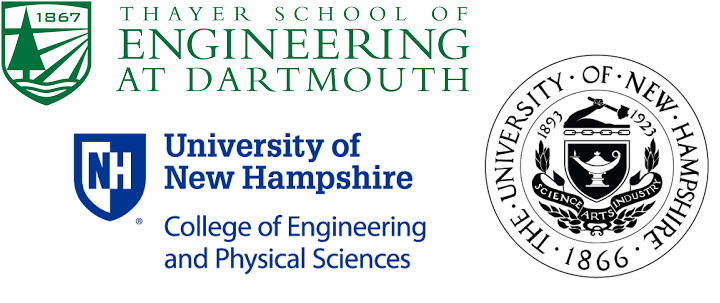This article features top engineering colleges in New Hampshire that offer master and doctoral degrees in the fields of biological engineering, chemical engineering, computer science, materials engineering, mechanical engineering, etc. Please be informed that each school receives national wide rank as the ranking compares all engineering schools in the United States. Some important ranking factors include average GRE scores, alumni surveys, current student interviews, institutional research publications, and peer college assessment. In the following list of best engineering schools in the state of New Hampshire, you can see tuition cost for both in-state and out-of-state students, acceptable rates and admissions statistics for each top ranked engineering college.

| National Ranking | New Hampshire Top Engineering Programs |
| 60 | Dartmouth College (Thayer) (Hanover, NH) Overall acceptance rate: 24.1% Average GRE quantitative score (master’s and Ph.D. students): 763 Tuition: Full-time: $41,736 per year Total graduate engineering enrollment: 267 Research expenditures per faculty member: $413,742 Engineering school research expenditures (2010-2011 fiscal year): $18,618,404 Faculty membership in National Academy of Engineering: 2.1% |
| 141 | University of New Hampshire (Durham, NH) Overall acceptance rate: 61.9% Average GRE quantitative score (master’s and Ph.D. students): 722 Tuition: In-state, full-time: $13,252 per year, Out-of-state, full-time: $25,680 per year Total graduate engineering enrollment: 249 Research expenditures per faculty member: $172,882 Engineering school research expenditures (2010-2011 fiscal year): $10,718,727 Faculty membership in National Academy of Engineering: 0.0% |
John McCain
In April 1979, during an official reception held for American legislators in Hawaii, McCain met Cindy Lou Hensley, the twenty-five-year-old daughter of prominent Arizona businessman Jim (James) Hensley. The girl lived in Phoenix and over the next few months, John and Cindy met in her hometown, then in Washington.
In the spring of 1980, John divorced his first wife, Carol. McCain not only left his ex-wife at home in Florida and Washington, but also provided her with ongoing financial assistance, including college education for her children and ongoing medical procedures Carol needed after her accident injuries. John and Carol maintained a good relationship (she always supported him in future political campaigns), but their children, of course, were stunned by the divorce and only after a few years began to communicate normally with their father again. Some of the McCains’ friends, including the Reagans, were also upset. Carol worked as a personal assistant to Nancy Reagan since the fall of 1979, and in 1981, when Ronald Reagan became the fortieth President of the United States, she received a post in the new administration (she was appointed director of the White House Visitors’ Office). However, a few years later, Ronald and Nancy Reagan, like others, renewed their friendship with John McCain.
On May 17, 1980, John McCain and Cindy Hensley married in Phoenix. Around this time, McCain decided to retire from military service. The state of his health did not allow him to pass the medical commission, which is mandatory for officers in command positions, he understood that he would not be able to repeat the achievements of his father and grandfather, who had risen to the rank of admiral. At the same time, he was increasingly attracted to a career in politics. On March 27, 1981, McCain donned his military uniform for the last time at his father’s funeral, and four days later, on April 1, he officially retired with the rank of captain. During the years of service, he was awarded the Silver Star, Bronze Star for Heroism, Legion of Honor, Flying Merit Cross, Purple Heart, Commendable Service medals. and others (a total of seventeen awards, not counting the three orders of South Vietnam). After John retired, the family moved to Arizona.
In Phoenix, John began working as vice president of public relations for his father-in-law’s Hensley Beverage Company, one of the largest distributors of Anheuser-Busch beer. McCain was not particularly interested in the beer business, but successfully established contacts with local businessmen and politicians. In March 1982, he announced his desire to run for a member of the House of Representatives from Arizona ‘s first district.. He was actively assisted in the campaign by, among others, George “Bud” Day, with whom McCain was once a prisoner of the Vietnamese. John’s supporters were then nicknamed the “McCain fleet”, and he himself, for his assertiveness and the color of gray hair, was called the “White Tornado”. McCain did not have enough funds for the campaign and he borrowed them from his wife (under the terms of the marriage contract, the spouses kept their finances separated and independently filed tax returns). McCain was then accused of wanting to get into Congress as an Arizona representative., although he did not live long in this state. The young politician then replied to his opponent: “I spent twenty-two years in the Navy. My father was in the Navy. My grandfather was in the Navy. We usually move often in the military service. We have to live in all parts of the country, in all corners of the world. I wanted I wish I had the luxury of being able to grow up and spend my whole life in a place as good as Arizona’s first county, but I was forced to do other things.In fact, when I think about it now, a place where I lived the most in my life, was Hanoi.” The result of McCain’s first election campaign was victory in the primary elections in September 1982, when he became the official candidate of the Republican Party,
